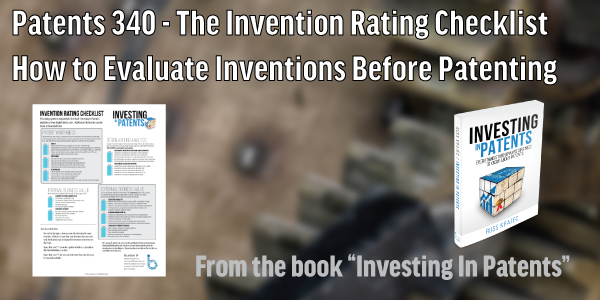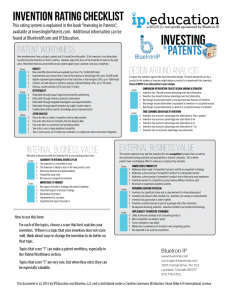Design Around Analysis For Your Invention
Design Around Analysis
The design around analysis is where we try to poke holes in the invention and find its weaknesses.
Sometimes, this can be very hard to do, and I have heard of companies who would put a separate team of engineers together to find a better way around an internal invention.
This process is very difficult for some entrepreneurs.
As part of my patent practice and my patent finance business, I meet with lots of inventors.
I often ask “So what is like your product?” and I get the reply “There is NOTHING like it.”
Not only is this claim disingenuous and untrue, it shows that the inventor has not thought through the competitive landscape.
There is ALWAYS something like your invention.
As an aside, when I hear that statement, it is a big red flag – especially as my role as an investor.
Assuming that it is true, it means that nobody in the market cares about your invention and there is no need for it.
Or it means that you will have to spend countless hours and huge amounts of money to educate the market that they need your product.
From a business standpoint, being the first to market is a long, lonely, and very expensive road.
It is almost always better to be the second one to market, where someone else paves the way and you can build on their successes and learn from their mistakes.
The old saying is that the second mouse gets the cheese.
But let’s get back to my statement: there is ALWAYS something like your invention.
In the design around analysis, we want to find the closest replacement for your invention.
Think about the world after your invention is in the market and before the invention.
Further, think about the world with and without the invention after everybody knows about it.
What are customers doing to solve the problem you address?
Right now, they might not know there is a problem.
How will the invention make their life better once they know about the invention?
We will take an oversimplified example of a self-cleaning soap dish which I made up.
I didn’t know that I needed a self-cleaning soap dish for my bathroom, but now that I have it, I don’t have to clean the dish any more.
In this example, what is the best alternative to a self-cleaning soap dish?
It is a regular soap dish that needs to be cleaned.
The net effect of the invention is that I save the time of having to clean the soap dish.
What is the value of that time?
For my house, it might be 5 minutes a month in the normal cleaning schedule, which may be generous.
Another thing to consider:
What is the world going to be like once everyone knows about your invention?
Many inventions really come from identifying a problem that needs to be solved, and in many cases, you just didn’t know you had the problem.
Henry Ford said that if he asked people what they wanted, they would have said faster horses.
After Henry Ford educated the public about automobiles.
Once they were in the market, there competitors came from everywhere.
Merely telling the people that they had a need – and showing them a solution – made the world a different place.
In the design around analysis, we want to find the best alternative for our solution, then measure the advantage of our solution over the alternative.
Always remember that the patent will be around for almost two decades.
Over the next twenty years, markets will change, technologies will evolve, consumer tastes will come and go: none of which is predictable or known.
A good invention maintains its edge for much of that lifecycle.
Back to the design around analysis.
We want to find inventions that are the absolute best way to solve a particular problem.
When there are other ways to solve the problem, our advantage is only that incremental improvement from the competitor’s solution to our’s.
A great way to do the design around analysis is this:
Assume that our competitor has the patent, not us.
How would we design around it?
If we have a set of claims, we can pick apart each element of the claims and see if it is necessary and whether we could find a different way to do that very element.
For example, let’s say that we have a lightbulb invention that has these elements:
a filament
electrical connections
a glass housing holding the filament under vacuum.
How would we design around this invention?
Is the filament necessary? Are there alternatives?
Sometimes light can be produced by exciting a gas with electricity, which is the fluorescent tube light.
The fluorescent light does not have a filament – so we can get around the patent.
Are the electrical connections necessary?
Probably, and we cannot change that.
What about the glass housing and the vacuum?
We could change it to some kind of plastic housing, but that would have production problems and would cost more than glass.
What I am doing here is to deconstruct the invention to its critical parts, then analyze each part individually.
Often, this kind of analysis will help us think through the details and further optimize our invention.
We might find that some elements might be critically important while other ones not so much.
We also might find that we can expand the product by capturing many different versions of it.
We also might find our product’s weaknesses – which could doom the invention.
This can be useful to help us understand the critical elements.
Not so incidentally, the critical elements find their way into the patent as the elements of the claims.
Another type of analysis is a higher level one.
Thinking back on the problem we are solving:
What other ways could we produce light?
There are LEDs, but there are also fire in its various forms: candles, lanterns, and so forth.
This thought experiment is trying to stand back and solve the problem differently.
Here, we are trying to see how our technology really stands up to a very broad category of competitors.
We are not trying to compare our lightbulb against someone else’s lightbulb:
we are trying to compare our solution to producing light compares to other solutions for producing light.
In this analysis, we might create a chart or spreadsheet and analyze all the competing ways to solve the same problem.
With each way, we should think through the advantages and disadvantages of each alternative.
Some may have higher performance but much higher cost.
Others may be lower cost but may have much less performance.
The point is to map out where our invention is strong and to try to quantify its performance advantages.
In some cases, these analyses will result in finding another invention that is better than our original one.
For example, if we think about the glass bulb in our lightbulb example, maybe there is a different shape or different way to make the bulb.
We dismissed the idea of making the bulb out of plastic, but maybe there are special cases where plastic makes sense.
Another technique may be to consider various use scenarios for your invention.
If you have a product that is used in a doctor’s office, will it translate to a dentist office?
Or a veterinarian? Or a hospital? A clinic? Onboard an ambulance?
In each of these use cases, the design around alternative might be different.
The purpose of these analyses is to make sure our investment will be a good one.
We don’t want to pursue a patent or a business that has some glaring weakness.
But many inventors struggle with this analysis.
It is very hard.
We are in love with our solution just because it is our baby.
But the market does not care about that.
The market only cares about whether your product is better somehow than your competitors.
As a side note, IP.Education has a product called the Invention Canvas.
This is a one page tool for helping you go through this analysis and pull and stretch your invention to see how it works in different situations.
The Invention Canvas is available on another video course.


